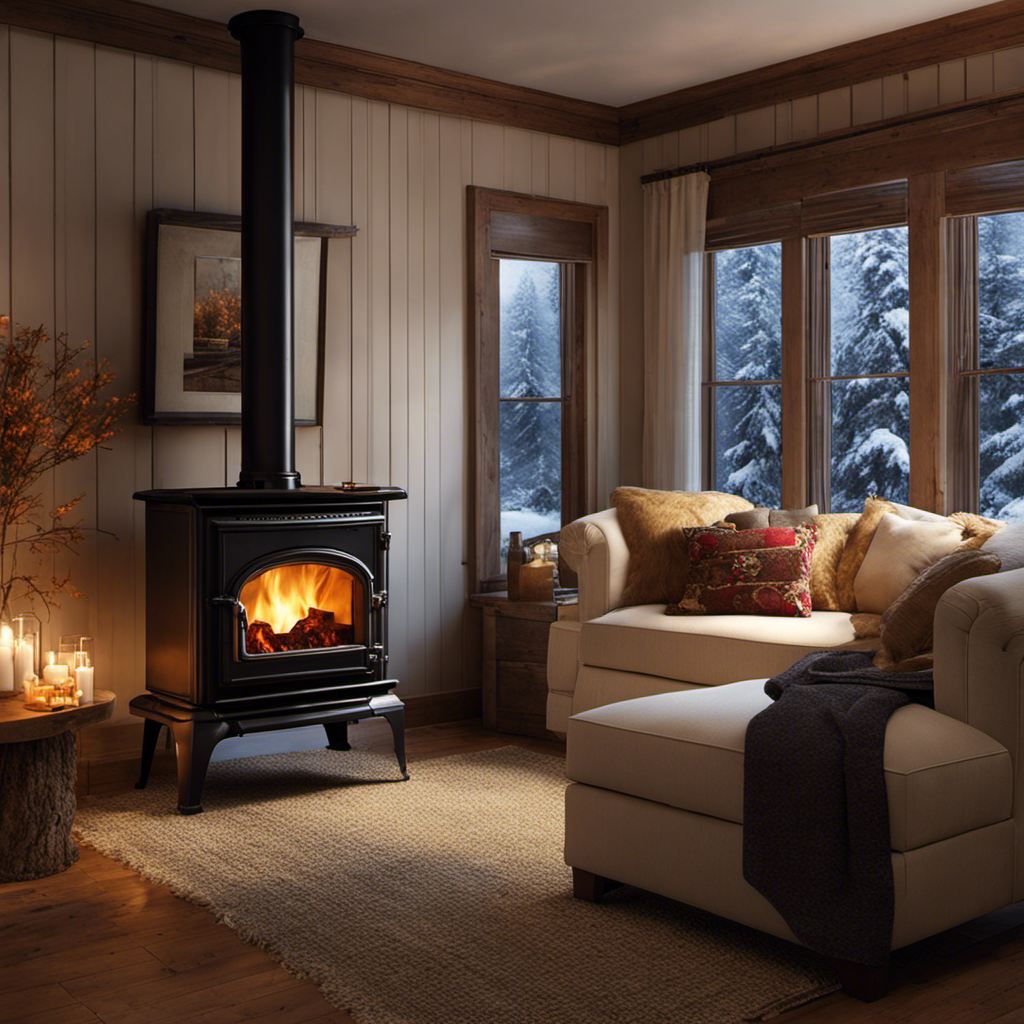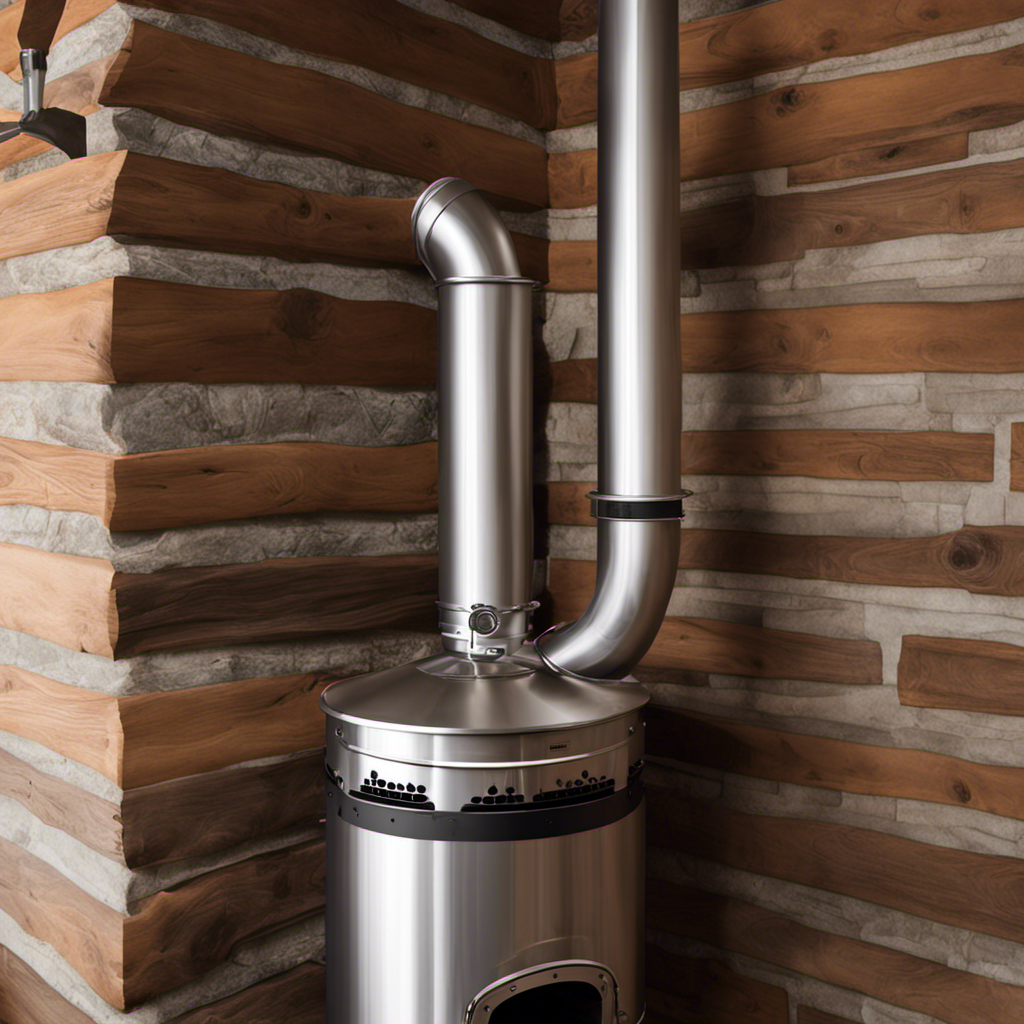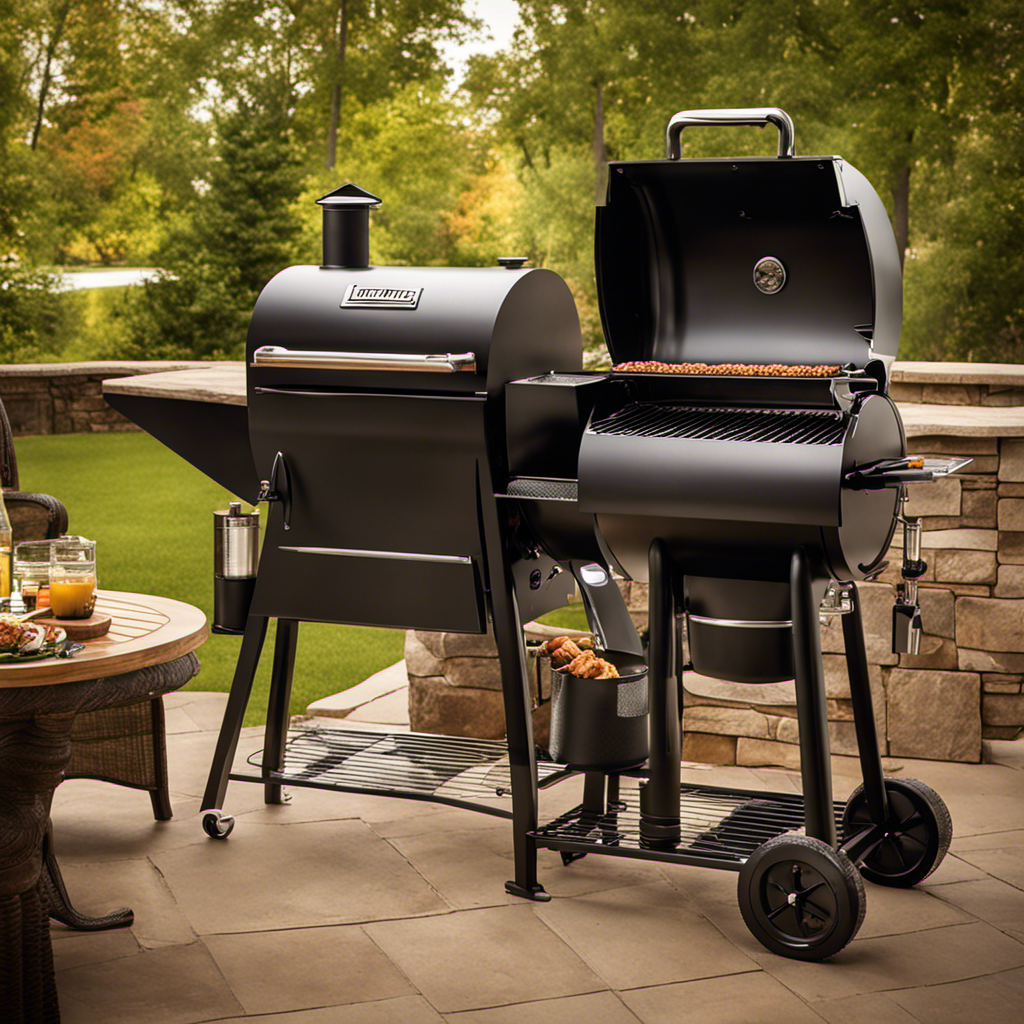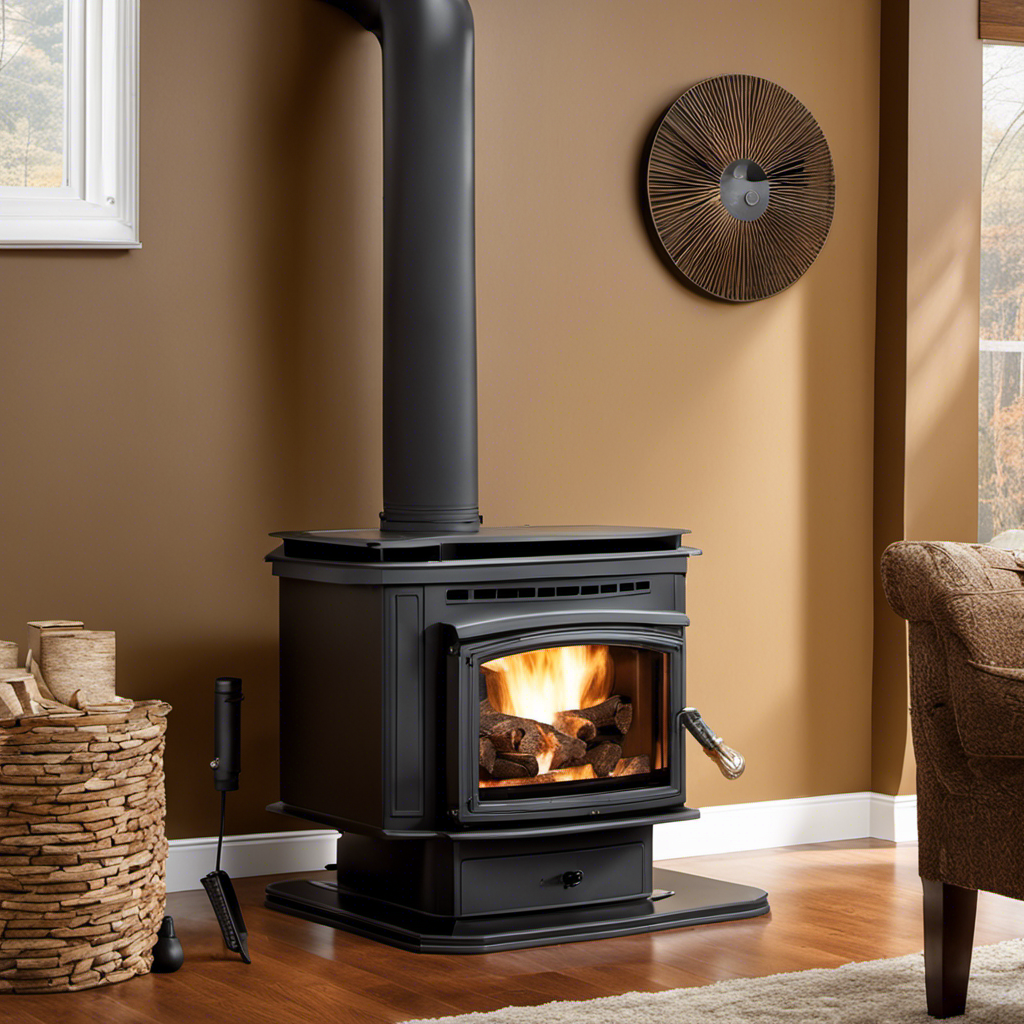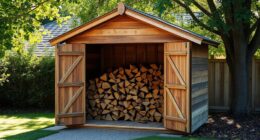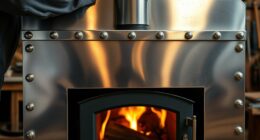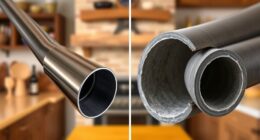Being an enthusiast of wood pellets, I have come to understand that discovering a high-quality wood pellet is similar to finding a gem among a wide variety of options. The numerous factors to consider can overwhelm anyone trying to determine which pellets are superior.
That’s why I’ve compiled this comprehensive guide to help you navigate the world of wood pellets. From size and shape to heat output and packaging quality, we’ll explore the key indicators of a high quality wood pellet.
So let’s dive in and uncover the secrets to finding the perfect pellet for your needs.
Key Takeaways
- The ideal size for high-quality wood pellets is around 6mm in diameter and 20-30mm in length, with a uniform shape and smooth surface for optimal combustion.
- Low density pellets with low moisture and ash content burn more efficiently, produce higher heat output, and result in cleaner emissions.
- Testing and certification processes, such as density measurement, ash content testing, and BTU rating, ensure that wood pellets meet required standards and guarantee quality and performance.
- The wood type used for pellets, with hardwoods like oak and maple being ideal, significantly affects pellet quality, energy content, burn characteristics, and efficiency.
Size and Shape
To determine if you have a high-quality wood pellet, you should examine its size and shape. The ideal size for a wood pellet is usually around 6mm in diameter and 20-30mm in length. This size ensures that the pellet will burn efficiently and evenly in your stove or fireplace.
Additionally, the shape of the pellet should be uniform, without any irregularities or deformities. A high-quality wood pellet will have a consistent and smooth surface, which allows for optimal combustion. The uniformity of shape also ensures that the pellets will flow smoothly through the feeding system of your stove or boiler.
By checking the size and shape of your wood pellets, you can ensure that you are using a high-quality product that will provide efficient and effective heat.
Now, let’s move on to the next aspect of determining wood pellet quality: density.
Density
When it comes to wood pellets, density plays a crucial role in determining their quality and performance. The density of a pellet affects its burn efficiency and heat output, making it an important factor to consider for consumers.
Measuring pellet density involves techniques such as weighing a known volume of pellets or using specialized instruments like a density meter.
Importance of Density
The density of a wood pellet directly affects its quality. When it comes to measuring density, it is important to understand the significance of low density.
Low density pellets are desirable for several reasons. Firstly, they tend to burn more efficiently, producing a higher heat output. This means you get more energy from each pellet, making them more cost-effective. Secondly, low density pellets tend to have lower moisture content, which makes them easier to ignite and burn consistently. Additionally, low density pellets typically have a lower ash content, resulting in less maintenance and cleaner emissions.
Now, let’s delve into the next section to explore the various methods used for measuring pellet density.
Measuring Pellet Density
Measuring pellet density can be done using various methods. One common method is the bulk density test, where the weight of a known volume of pellets is measured. This provides an indication of how tightly packed the pellets are.
Another method involves using an electronic density meter, which uses sound waves to determine the density of the pellets. This method is more precise and gives accurate results.
Measuring pellet density is important because it can indicate the quality of the pellets. High-quality wood pellets have a higher density, which means they have more energy content per unit volume. This is an important factor in wood pellet certification, as it ensures that the pellets meet the required standards.
Now, let’s move on to measuring pellet moisture content, another important aspect of wood pellet quality.
Moisture Content
To determine if a wood pellet is of high quality, you can feel the moisture content. The drying process plays a crucial role in creating quality wood pellets. During this process, the moisture level is reduced to an optimum range, typically around 6-8%. This low moisture content is important because it ensures efficient combustion and prevents excessive smoke and creosote buildup in the stove or furnace.
When you touch a high-quality wood pellet, it should feel dry and smooth, without any dampness or stickiness. Excess moisture can lead to poor combustion and reduced heat output.
Now, let’s move on to another important factor in determining wood pellet quality: ash content.
Ash Content
When it comes to wood pellets, the importance of low ash content cannot be overstated. Low ash content is crucial because it directly impacts the efficiency and cleanliness of the pellet stove or boiler.
Ash content standards have been established to ensure that wood pellets meet certain quality criteria, typically ranging from 0.5% to 1.5% ash content.
Testing techniques for ash include methods such as the loss-on-ignition method, which measures the amount of ash left behind after the pellet is burned, providing an accurate assessment of its ash content.
Importance of Low Ash
If you want to ensure you are using a high-quality wood pellet, you should pay attention to the amount of ash it produces. The amount of ash left over after burning a wood pellet is a good indicator of its quality.
Here are some key things to consider when measuring ash and testing moisture in wood pellets:
- Look for wood pellets with low ash content, preferably less than 1%.
- Use an ash content tester to accurately measure the amount of ash produced by a wood pellet.
- Test the moisture content of wood pellets using a moisture meter to ensure they are properly dried.
- High-quality wood pellets should have a moisture content of around 6-8%.
- Avoid wood pellets with high ash content or excessive moisture, as they can lead to poor combustion and reduced efficiency.
By paying attention to the amount of ash and moisture in wood pellets, you can ensure you are using a high-quality product that will provide optimal performance in your pellet stove or boiler.
Now, let’s delve into the ash content standards to understand their significance.
Ash Content Standards
Understanding the ash content standards is crucial for selecting the right wood pellets for your stove or boiler. Ash content refers to the amount of residue left after burning the pellets.
The importance of low ash content is two-fold. Firstly, it affects the efficiency of your heating system. High ash content can lead to clogging and reduced heat output, requiring more frequent maintenance and cleaning. Secondly, low ash content is an indicator of the quality of the wood pellets. High-quality pellets have low ash content because they are made from premium wood fibers that burn more completely.
To ensure you are getting the best wood pellets, it is essential to check for ash content standards set by regulatory bodies. These standards provide guidance on the acceptable levels of ash content in wood pellets.
Transitioning into the subsequent section about testing techniques for ash, it is important to understand the various methods used to determine ash content accurately.
Testing Techniques for Ash
To accurately determine the ash content of your chosen wood pellets, it’s important to be aware of the various testing techniques available.
Ash testing techniques can vary depending on the specific requirements and standards set by organizations such as the American Society for Testing and Materials (ASTM) or the International Organization for Standardization (ISO). These techniques typically involve burning a sample of the wood pellets and measuring the resulting ash residue. The ash content is usually expressed as a percentage of the original sample weight.
Some common ash testing techniques include the muffle furnace method, where the sample is heated in a controlled environment, and the crucible method, where the sample is burned in a crucible. These techniques ensure accurate measurement of the ash content, providing valuable information about the quality of the wood pellets.
Speaking of quality, let’s now explore the important aspect of heat output.
Heat Output
You can easily determine the heat output of a high quality wood pellet by checking the BTU rating. The BTU rating stands for British Thermal Unit, which measures the energy content of a fuel. A higher BTU rating indicates a greater heat output.
When it comes to wood pellets, heat efficiency and combustion rate are crucial factors to consider. A high quality wood pellet will have a high heat efficiency, meaning it will burn efficiently and release more heat energy. Additionally, a high quality wood pellet will have a consistent and controlled combustion rate, ensuring a steady and reliable heat output.
By checking the BTU rating of a wood pellet, you can gauge its heat output potential and determine if it is a high quality product.
Moving forward to the next section, let’s explore the importance of understanding the BTU rating in more detail.
BTU Rating
Finding the BTU rating is essential for determining the heat output potential of a wood pellet. The BTU (British Thermal Unit) rating measures the amount of heat energy produced by the pellet. When looking for high quality wood pellets, it is important to consider the BTU rating along with other factors such as moisture content.
Here are two things to consider when evaluating the BTU rating:
-
Moisture content: Wood pellets with low moisture content have a higher BTU rating. Moisture in the pellets reduces the amount of energy they can produce when burned, so it is important to choose pellets with a moisture content of less than 10%.
-
Consistency: Look for wood pellets that have a consistent BTU rating across the entire batch. Inconsistent BTU ratings can result in uneven heat output and inefficient burning.
Understanding the BTU rating and considering factors like moisture content can help you identify high quality wood pellets. Now, let’s move on to the next section about ‘wood type’ and explore its impact on pellet quality.
Wood Type
When it comes to wood pellets, the type of wood used plays a crucial role in determining their quality. Different wood types have varying levels of energy content and burn characteristics, so choosing the ideal wood type is essential.
Additionally, the quality of wood pellets can be indicated by factors such as moisture content, ash content, and pellet density, which affect their performance and efficiency.
Ideal Wood Types
To determine the ideal wood types for high-quality wood pellets, look for those made from hardwoods like oak or maple. These hardwoods have a higher density and produce a greater heat output compared to softwoods. Here are three reasons why hardwoods are the ideal choice for wood pellets:
-
Higher Heat Output: Hardwoods have a higher energy content, which means they produce more heat when burned. This makes them more efficient for heating purposes.
-
Longer Burn Time: Hardwood pellets tend to burn slower and provide a longer-lasting heat source. This is beneficial, especially during colder months when you want to maintain a consistent temperature.
-
Reduced Ash Content: Hardwood pellets typically have lower ash content compared to softwood pellets. This means less cleaning and maintenance, as there will be fewer ashes to dispose of.
Considering these factors, it is clear that hardwoods like oak or maple are the ideal wood types for high-quality wood pellets.
Now, let’s move on to the next section about quality indicators.
Quality Indicators
Now that we’ve discussed the ideal wood types for wood pellets, let’s explore some quality indicators to look for.
When it comes to measuring efficiency, one key factor to consider is the pellet’s density. High-quality wood pellets are denser, meaning they contain more energy per unit volume. Look for pellets that are heavy and compact.
Another important indicator is the moisture content. Low moisture levels ensure efficient combustion and prevent excess smoke and ash.
Additionally, it is crucial to consider the environmental impact of the pellets. Look for certifications such as the Forest Stewardship Council (FSC) or the Sustainable Forestry Initiative (SFI) to ensure that the pellets are sourced sustainably.
Now, let’s delve into the manufacturing process and discover how these high-quality wood pellets are made.
Manufacturing Process
If you’re looking for a high quality wood pellet, you’ll want to consider the manufacturing process. Here’s what you need to know:
-
Measuring Moisture:
-
High quality wood pellets have a moisture content of less than 10%. This ensures optimal combustion efficiency and reduces the risk of creosote buildup in your stove or fireplace.
-
Manufacturers use advanced moisture testing equipment to accurately measure the moisture levels in the raw materials before pellet production.
-
Packaging Standards:
-
High quality wood pellets are packaged in durable, moisture-resistant bags to ensure that they reach you in perfect condition.
-
Look for pellets that are sealed properly to prevent moisture absorption during storage and transportation.
By understanding these aspects of the manufacturing process, you can make an informed decision when choosing high quality wood pellets.
Now let’s delve into the next section, which focuses on certification and testing, to further assess the quality of wood pellets.
Certification and Testing
When considering certification and testing, look for reliable indicators that guarantee the quality and performance of the wood pellets you’re purchasing. The certification process ensures that the manufacturer meets specific industry standards and regulations. Look for certifications such as ENplus or Pellet Fuels Institute (PFI) to ensure that the pellets have been produced using high-quality materials and processes.
Testing standards are also crucial in determining the quality of wood pellets. Look for pellets that have been tested for moisture content, ash content, and bulk density. These tests provide valuable information about the efficiency and environmental impact of the pellets. Additionally, some manufacturers may conduct additional tests for attributes like durability and heat output.
By choosing wood pellets that have undergone a thorough certification process and meet rigorous testing standards, you can be confident in their quality and performance.
Now, let’s move on to the next aspect to consider: packaging quality.
Packaging Quality
Packaging plays a crucial role in preserving the freshness and integrity of the pellets, so it’s important to choose bags that are durable and properly sealed. When it comes to packaging quality, here are five key factors to consider:
-
Moisture control: Look for bags that have an effective moisture barrier to prevent moisture from seeping into the pellets. This helps maintain their quality and prevents mold growth.
-
Durability: Opt for bags that are strong and resistant to tearing. This ensures that the pellets are protected during transportation and storage.
-
Proper sealing: Make sure the bags are properly sealed to prevent any air or moisture from entering. This helps in maintaining the freshness of the pellets.
-
Environmental impact: Consider packaging options that are environmentally friendly, such as bags made from recycled materials or those that are biodegradable.
-
Labeling: Look for bags that provide clear labeling with important information, such as the type of wood used, the heat output, and any certifications.
Considering these factors will ensure that you choose high-quality packaging for your wood pellets, maintaining their freshness and integrity while minimizing their environmental impact.
Moving on to price comparison, it’s important to evaluate the cost of different brands and packaging options.
Price Comparison
Moving on to price comparison, it’s important to consider the cost of different brands and packaging options. When it comes to wood pellets, the price can vary depending on the quality and performance of the product. To help you make an informed decision, I’ve compiled a table comparing the moisture level and heat efficiency of different wood pellet brands:
| Brand | Moisture Level | Heat Efficiency |
|---|---|---|
| Brand A | 5% | 90% |
| Brand B | 8% | 85% |
| Brand C | 10% | 80% |
| Brand D | 12% | 75% |
| Brand E | 15% | 70% |
As you can see, the moisture level and heat efficiency of wood pellets can vary significantly. Higher moisture levels can lead to decreased heat efficiency and increased ash production, resulting in a less efficient burn. Therefore, it’s important to choose a brand with a low moisture level and high heat efficiency for optimal performance and cost-effectiveness.
Is the Btu Rating a Good Indicator of High Quality Wood Pellets?
When considering wood pellet btus rating, it’s important to remember that it alone does not determine quality. While a higher Btu rating can indicate more energy output, other factors like ash content and moisture levels also impact performance. It’s best to consider multiple factors when selecting high quality wood pellets.
Does the Btu Rating of Wood Pellets Determine Their Quality?
When it comes to choosing the best wood pellets for your stove or fireplace, considering the wood pellet BTUs rating is crucial. The higher the BTU rating, the more heat the pellets will produce, making them more efficient and cost-effective. Always check the wood pellet BTUs rating before making a purchase.
Frequently Asked Questions
Can Wood Pellets Be Used in All Types of Pellet Stoves and Boilers?
Wood pellet compatibility varies depending on the specific stove or boiler. It is important to consult the manufacturer’s guidelines to ensure that your appliance is compatible. If not, consider alternative heating options.
Are There Any Environmental Benefits to Using High-Quality Wood Pellets?
Using high-quality wood pellets has environmental benefits such as reduced emissions and increased energy efficiency. They burn more efficiently, leaving less ash and producing more heat. It’s like getting more bang for your buck.
How Long Can Wood Pellets Be Stored Before They Start to Degrade in Quality?
Wood pellet storage duration can vary depending on factors such as moisture content, temperature, and packaging. Over time, pellets may degrade in quality, so it’s important to properly store them to maintain their effectiveness.
Can High-Quality Wood Pellets Be Used in Other Applications, Such as Grills or Smokers?
High-quality wood pellets are versatile and can be used in grills and smokers. They provide a consistent burn, produce less ash, and impart a delicious smoky flavor to food.
Are There Any Specific Safety Precautions to Consider When Handling or Storing Wood Pellets?
When it comes to safety precautions, handling and storage of wood pellets, it’s important to keep them in a cool, dry place away from any heat sources or flammable materials. Always wear protective gloves and follow manufacturer guidelines for safe handling.
Conclusion
After diving deep into the world of wood pellets and learning about their various qualities, it’s safe to say I’ve become quite the connoisseur. Who knew there was so much to consider when determining the quality of these little heating gems?
From size and shape to density and moisture content, every aspect plays a crucial role in ensuring a high-quality wood pellet. And let’s not forget about the ash content and heat output, which can make or break the efficiency of your heating system.
So, next time you’re in the market for wood pellets, remember to look for the perfect blend of irony and knowledge to ensure you’re getting the best bang for your buck.
Growing up surrounded by the vast beauty of nature, Sierra was always drawn to the call of the wild. While others sought the comfort of the familiar, she ventured out, embracing the unpredictable and finding stories in the heartbeat of nature.
At the epicenter of every remarkable venture lies a dynamic team—a fusion of diverse talents, visions, and passions. The essence of Best Small Wood Stoves is crafted and refined by such a trio: Sierra, Logan, and Terra. Their collective expertise has transformed the platform into a leading authority on small wood stoves, radiating warmth and knowledge in equal measure.


